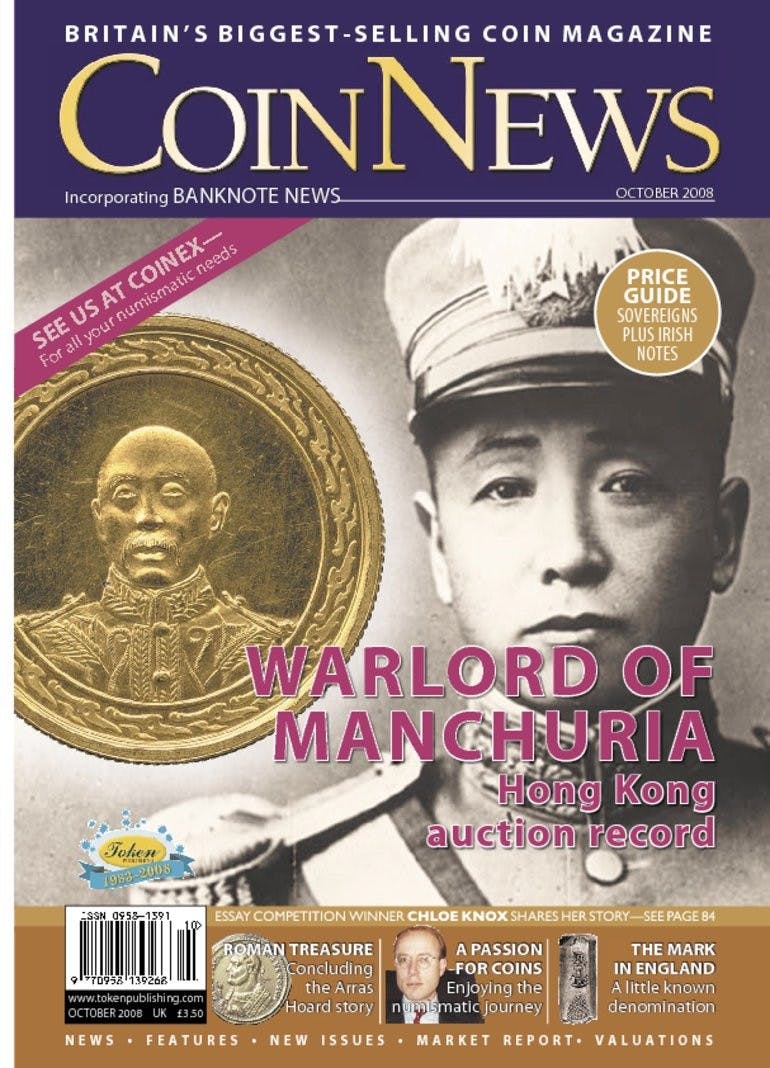Hong Kong Auction Record - NO LONGER AVAILABLE
Volume 45, Number 10, October 2008
Compulsive Viewing Every fortnight our Marketing Director, Philip, has a slot on BBC Radio Devon talking about coins and medals. It’s a popular section of the afternoon programme and every week he gets a wide variety of calls from members of the public, all eager to know more about the items from their collections (or those they’ve found in the attic) and quite often we get listeners coming in to the office to pick our brains further. He has had a wide variety of coins and other numismatica to try to identify and so far has yet to be stumped—the people of Devon happy to have an “expert” on hand to help. However, no matter whether it is a Royal Mint Year set, a 1967 penny or a spade guinea that’s being described by the caller, one thing is certain: what they all really want to know, when all is said and done, is “what’s it worth?”. Our hobby is odd like that, I’ve mentioned before how, if we were collectors of postcards, matchboxes, wine labels or a thousand other things, then the value wouldn’t ever be that much of an issue. True, every hobby has its rarities, and there are sure to be costly examples of matchboxes or wine labels—and I know first-hand how postcards can vary hugely in price. However, I defy anybody to pick up an old postcard and think immediately of its worth and yet if they find an old coin that is exactly what they’ll wonder about first. Admittedly, if you look at our hobby as part of the “antique” rather than the “collectable” world, then you’ll see that such thoughts about value are not uncommon—programmes like “Cash in the Attic”, “Bargain Hunt” and of course “Antiques Roadshow” are testament to that. Part of the reason for this is of course the large sums that coins regularly fetch these days, particularly at auction. These headline sums, like that realised at the Baldwin’s sale in Hong Kong for the Chang Tso Lin pattern gold $50 (see “Market Scene”), inevitably attract attention and everyone hopes that they too can see their coins making a life changing amount of money. . . you just don’t see matchboxes making half a million dollars! The problem is that whilst gold $50 coins, unique 20 rouble pieces like that featured in St James’s next sale, 1933 pennies, double eagles or even double leopards, may grab the headlines, the vast majority of us will not only never own such coins, the chances are we’ll never even get to see them and must instead “make do” with lesser pieces that whilst interesting will never make us vastly rich! Now this then begs the question: just how relevant to our hobby are these “headline” coins? Are they really part of the same pastime as a Victorian shilling, long cross penny or modern year set? There are some who say not and who think of the big money coins as a different animal to the run of the mill pieces that appear on dealers’ lists and at fairs. After all, they are far beyond the scope of most collectors and should be treated as pleasant distractions and nothing more. Indeed, we do occasionally get letters with regard to this very subject, particularly in relation to our “Market Scene” coverage. Why, the writers ask, do we bother to highlight the huge prices for the star coins when they have no relevance to most collectors at all? Why don’t we instead spotlight the ordinary lots? Those that most of our readers have an outside chance of owning? Well, we like to think we do that too, but we do accept that often it’s the big money coins that get most of the coverage. The reason for this is something I think of as the “Top Gear” principle. For those of you who don’t know, “Top Gear” is a motoring programme hosted by the outspoken Jeremy Clarkson, a man for whom the concept of “global warming” is actually a great excuse not to have to buy a 14 tog duvet! His attitude, as well as that of his co-presenters, is that “bigger, faster, noisier is better” and they regularly showcase, not the everyday cars that most of their viewers will actually drive, but rather the Aston Martins, Ferraris, Porsches and Lamborghinis that they aspire to. Yes, they recognise that no more than a handful of those watching will ever own such a machine, but they also know that nearly everyone of their audience would want to! So it is with these unattainable coins—we may never get to own one ourselves, but we sure wish we could and who knows... maybe one day, Lottery win permitting! Talking of “unattainable” and unique coins, I have one more question: why do some unique or exceptionally rare coins fetch astronomical sums whilst others are apparent bargains? There is a unique Celtic coin of Eppillus being offered for sale in November and it is expected to fetch £3,000. This is undoubtedly a good price for a Celtic piece, but come on everyone, Unique is Unique, it is one of a kind. Other extreme rarities fetch ten, twenty, a hundred times that figure. I’ve never quite worked out why!
Order Back Issue
You can order this item as a back issue, simply click the button below to add it to your shopping basket.

